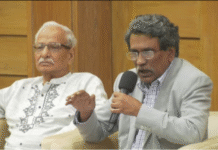Economic dev must come with democracy, human rights: US ambassador
 The Indo-Pacific Strategy is an interplay of geo-strategy, geo-politics, geo-economics and even geo-energy. It is still in its formative stage, a developing concept. It is being seen as an approach by the US to contain Chinese influence. Will it turn the region into a more peaceful one? Or will it revive the Cold War paradigm?
The Indo-Pacific Strategy is an interplay of geo-strategy, geo-politics, geo-economics and even geo-energy. It is still in its formative stage, a developing concept. It is being seen as an approach by the US to contain Chinese influence. Will it turn the region into a more peaceful one? Or will it revive the Cold War paradigm?
These observations and questions were raised at a roundtable on ‘Indo-Pacific Strategy: Implications for the Region’, held yesterday (Monday), at the Daily Star Centre in the capital city.
Organised by the think-tank Bangladesh Institute of Peace and Security Studies (BIPSS), the discussion was attended by academics, diplomats, former military persons, geo-strategic experts, analysts of regional affairs, journalists, students and others.
Terming the ‘free and open Indo-Pacific’, or FOIP, as a work in progress, assistant professor of East West University Parvez Karim Abbasi said that China’s Belt and Road Initiative has overshadowed other such initiatives.
He said that the Indo-Pacific Strategy was a “late approach by the Americans to contain Chinese influence.”
He said that BRI involves roads, bridges, connectivity, digital connectivity and more. The region needed 26 trillion dollars for development and China stepped in.
The US on the other hand, he pointed out, is a large export destination for Bangladesh, the largest investor, but unfortunately does not provide duty-free or quota free access for Bangladesh products.
“China uses economic leverage,” Abbasi continued, “and doesn’t hector. China is a friend who doesn’t judge and everyone likes such friends.”
US ambassador Earl R Miller said that the US Indo-Pacific vision was an effort to support a free Indo-Pacific region. He agreed that the US hadn’t done enough in advertising what the Indo-Pacific Strategy was all about and China, in that sense, had done a better job on BRI.
“US has been accused of hectoring,” he also admitted, but explained that this was because of certain values and principles. “Economic development must come with respect for democracy and human rights,” he said, adding, “US companies want to invest in Bangladesh, but they also observe the state of human rights and the rule of law in the country.”
He rejected the idea that the Indo-Pacific Strategy was an attempt to contain China, saying that the strategy excludes no nation.
“This is not our version of BRI,” he emphasised, saying that it encouraged the US private sector to invest in the region.
“The key priority is private sector economic growth,” he said. “US companies want to invest in the region and the countries of the region must do their part. They must roll out the red carpet, not the red tape.”
Professor Amena Mohsin of Dhaka University’s department of international relations said that the Indo-Pacific Strategy must not neglect the need for there to be a connectivity of minds.
She stressed the importance of people-to-people contact and ‘soft diplomacy’.
Former ambassador Shamim Ahmed said that the Indo-Pacific Strategy was still a nebulous concept and until it grew into a more definite shape, it would be hard to determine what stand to take.
“I would tread the path of caution,” he said. “Scrunitising its various aspects along the way.”
Niloy Ranjan Biswas, associate professor of the department of international relations at Dhaka University, said that the Indo-Pacific Strategy still seems to be on paper and it must be determined how it will be implemented.
“There is a long way to go before we explore the benefits of the strategy,” he said. He wondered how this would impact on the traditional rivalry between India and Pakistan as both were countries of the Indo-Pacific region.
Professor Imtiaz Hussain, of Independent University’s global studies and governance programme, recalled how in the past, India’s prime minister Narashima Rao at the time had taken up a ‘Look East policy’.
Now, he said, Modi’s policy was ‘Act East’. The region was now an engine of global growth, he said, pointing to a ‘glacial shift of the Atlantic order to an Asian order.”
Shahedul Anam Khan, associate editor of the Daily Star, said that the Indo-Pacific Strategy was in the making, in the development phase.
“This strategy proves the forecast that the 21st century will be an Asian century, determined by China, India and Japan. The Indo-Pacific Strategy is a geo-political reality spurred on by the rise of India and China,” he said.
Moderating the overall discussion, BIPSS president ANM Muniruzzaman clarified that the ‘Indo’ in ‘Indo-Pacific’ was not India, but the Indian Ocean.
It signified a single geo-strategic space. He said that there were exclusive concepts and inclusive concepts involved. Given China’s BRI looming large in the region and the onset of the Indo-Pacific Strategy, he quoted the Singapore prime minister Lee Hsien, saying, “We do not want to end up with rival blocs forming or countries having to take one side of the other.”









